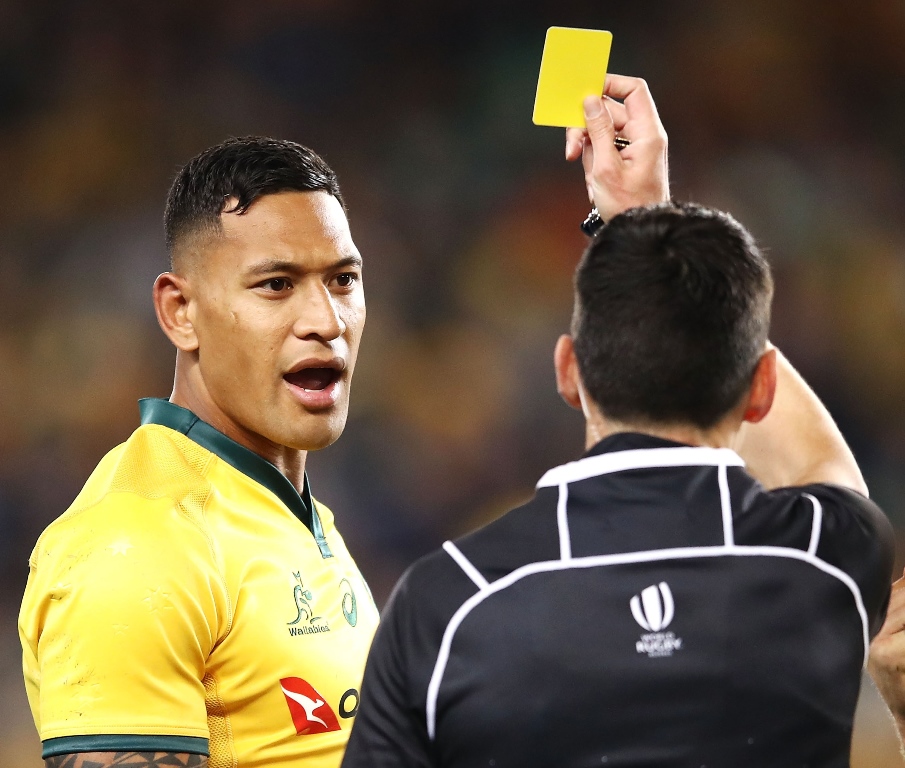Jackson column: Lack of TV coverage makes referees the fall-guy

MK2_6045
By Peter Jackson
Benjamin Fall goes up for a high ball and his mid-air opponent, Beauden Barrett, comes crashing down on his neck. Neither player has a leg to stand on, nor do the law enforcers running World Rugby.
The book demands a red card and the baffled France full-back duly gets one which makes him the ultimate Fall-guy.
Seven days later an identical scenario ends with Australia‘s Israel Folau and Ireland‘s Peter O’Mahony in a similarly legless state after falling from a similar height. This time the full-back, every bit as baffled as his French opposite number, escapes with nothing worse than a yellow.
Similar offences, committed on opposite sides of the Tasman on successive Saturdays, produce different outcomes but that is barely the half of the story. It gets worse, a whole lot worse.
Far from endorsing the action of referee Angus Gardner, an independent disciplinary panel rules that the Australian official made a mistake. Fall should not have been sent off because Fall had done nothing wrong, a point he clearly tried to make at the time.
The sending-off was quashed, the red card rescinded. The verdict would have intensified French grievance, amounting to confirmation that an interesting Test match had been thrown hopelessly off-balance for no justifiable reason.
How then could the referee, the two assistant referees and the TMO have got it so badly wrong. The New Zealand pundits, including the admirably objective Justin Marshall, agreed that Gardner had been left no option and from a distance of 12,000 miles it looked an open-and-shut case.
The public furore prompted World Rugby into issuing a statement designed to cut through the fog of confusion. It turned out to be less an explanatory note, more a case of the governing body digging themselves into a deeper hole.
In deciding to send Fall off, Gardner and the officials had ‘followed the guidelines correctly and made a decision based on the available camera angles’.
It was ‘only during the subsequent review by an independent judicial panel, when additional camera angles were made available, was it determined that Benjamin Fall was knocked off balance immediately prior to the challenge and therefore the red card was dismissed’.
The angles showed how Fall’s challenge had been interfered with by the blocking of All Black centre Ryan Crotty. Why were they not available to the TMO (ex-Australian referee George Ayoub) at the time?
At best it sounded unsatisfactory, at worst amateurish. After all, what is the point of the process unless all angles are available, especially one which would have put Fall’s innocence beyond doubt and spared both he, and his team, a gross injustice?
That, though, is only the half of it. One week a referee is deemed to have been wrong to show a red card for an aerial challenge. Seven days later, a different referee is deemed to have been wrong to use a yellow card for a virtually identical offence.
Pascal Gauzere of France allowed Folau to reinforce the Wallaby ranks against Ireland after he had spent ten minutes in the bin. Another disciplinary panel then swung into action once the citing commissioner had decided that Folau had a red-card case to answer.
Indeed he had and a one-match ban followed. It caused predictable outrage, provoking three former Wallabies – George Gregan, Brendan Cannon, Drew Mitchell – to voice fears for the sport. Mitchell claimed that ‘the level of frustration is turning people away from our great game’.
World Rugby have found it necessary to restate the guidelines for aerial combat which have been operational for two years: “’If a player is not in a realistic position to gather the ball, there is contact and the other opponent lands on their (sic) back or side – yellow card.
“If a player is not in a realistic position to gather the ball, there is reckless or deliberate foul play and the player lands in a dangerous position – red card.
“A player having eyes on the ball is not, in itself, a mitigating factor when the match officials are determining whether potential foul play has been committed. The primary consideration is whether both players were in a realistic position to gather the ball.”
The dismissal of Folau’s appeal has done nothing to ease the sense that the law, in this particular, is an ass. The Wallaby full-back’s wife, Maria, would certainly appear to be of that opinion.
She tweeted a video of hubby taking a high ball before tumbling to the ground after colliding with a player in green during the three-match series against Ireland. It could have been from the opening seconds of the decisive third Test last Saturday.
Folau leaps to take Johnny Sexton’s kick off. His challenger, Rob Kearney, is in anything but ‘a realistic position’ to compete for the ball yet neither the referee nor the TMO considers it worth a second look.